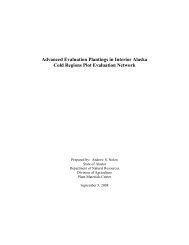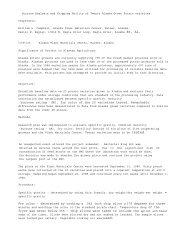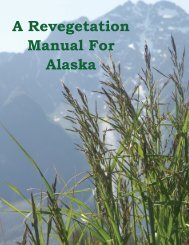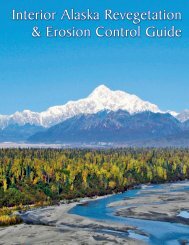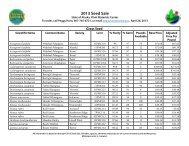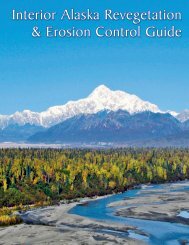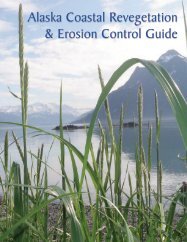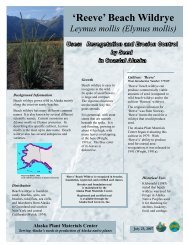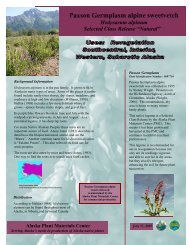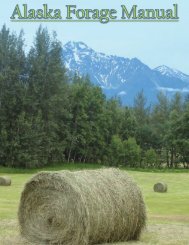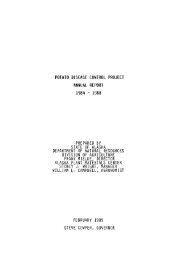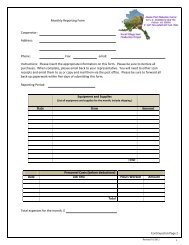Alaska Forage Manual - Alaska Plant Materials Center - State of ...
Alaska Forage Manual - Alaska Plant Materials Center - State of ...
Alaska Forage Manual - Alaska Plant Materials Center - State of ...
Create successful ePaper yourself
Turn your PDF publications into a flip-book with our unique Google optimized e-Paper software.
Fertilized stands <strong>of</strong> Bluejoint may produce 2 or 3 times more<br />
total forage than unfertilized stands. Also, fertilized stands<br />
can produce 10-20% higher protein yields and are considered<br />
more palatable for livestock and wildlife. Problems can occur<br />
with virgin stands <strong>of</strong> Bluejoint Reedgrass due to the large<br />
amount <strong>of</strong> surface debris that can accumulate from previous<br />
years’ growth. This hummocky layer can prevent top dressed<br />
fertilizers from reaching the living grass root zone. This layer<br />
can be removed by burning, blading, or mechanical mixing <strong>of</strong><br />
the surface organic layer.<br />
Photo: Brennan Veith Low, AK PMC<br />
Grass<br />
Several potential pests have been associated with Bluejoint<br />
Reedgrass throughout the lower 48 states and parts <strong>of</strong> <strong>Alaska</strong>.<br />
The nematode Subanguina calamagrostis invades the leaf<br />
tissue <strong>of</strong> the grass, forming galls that cause the leaves to become<br />
twisted and contorted. A fungus, Dilophospora alopecuri, can<br />
then invade the leaves <strong>of</strong> Bluejoint Reedgrass, using the entry<br />
wound caused by the aforementioned nematode.<br />
Cultivars and Releases<br />
• ‘Sourdough’ - University <strong>of</strong> <strong>Alaska</strong> Fairbanks release.<br />
A W I SW SC SE<br />
References<br />
Wright, S.J. and P.K. Czapla (2010) <strong>Alaska</strong> Coastal Revegetation & Erosion<br />
Control Guide, <strong>State</strong> <strong>of</strong> <strong>Alaska</strong>, Division <strong>of</strong> Agriculture, <strong>Plant</strong> <strong>Materials</strong><br />
<strong>Center</strong>, Anchorage, <strong>Alaska</strong>. 234 pp Link: http://plants.alaska.gov/reveg/<br />
Wright, S.J. and P. Hunt (2008) A Revegetation Guide for <strong>Alaska</strong>, <strong>State</strong> <strong>of</strong><br />
<strong>Alaska</strong>, Division <strong>of</strong> Agriculture, <strong>Plant</strong> <strong>Materials</strong> <strong>Center</strong>, Anchorage, <strong>Alaska</strong>.<br />
160 pp Link: http://plants.alaska.gov/pdf/Reveg<strong>Manual</strong>.pdf<br />
Klebesadel, L.J. (1983) <strong>Forage</strong> Crops In <strong>Alaska</strong> - Bulletin 63, University <strong>of</strong><br />
<strong>Alaska</strong>, School <strong>of</strong> Agriculture and Land Resource Management, Agricultural<br />
Experiment Station. 16 pp<br />
Klebesadel, L.J., R.L. Taylor, W.M. Laughlin, W.W. Mitchell, G.J. Michaelson<br />
and J. Purser (1983) Grain and <strong>Forage</strong> Crops for Southcentral <strong>Alaska</strong>,<br />
University <strong>of</strong> <strong>Alaska</strong> , Palmer <strong>Alaska</strong>. 10pp<br />
Natural Resource Conservation Service (2000) USDA National <strong>Plant</strong> Data<br />
<strong>Center</strong> [online] Link: http://plants.usda.gov/java/<br />
Skinner, Q.D, Wright, S.J., Henszey, R. J., Henszey, J.L. and Wyman, S.K.<br />
(2012) A Field Guide to <strong>Alaska</strong> Grasses, Education Resources Publishing,<br />
Cummings Georgia. 384 pp<br />
A mature stand <strong>of</strong> Bluejoint Reedgrass<br />
Klebesadel, L.J. and Laughlin, W.M. (1964) Utilization <strong>of</strong> Native Bluejoint<br />
Grass in <strong>Alaska</strong>, University <strong>of</strong> <strong>Alaska</strong>, Agricultural Experiment Station. 22 pp<br />
Stubbendieck, J., S.L. Hatch, L.M. Landholt (2003) A Field Guide, North<br />
American Wildland <strong>Plant</strong>s, University <strong>of</strong> Nebraska, University <strong>of</strong> Nebraska<br />
press. Lincoln, Nebraska. 501 pp<br />
A<br />
W<br />
I<br />
SW<br />
SC<br />
SE<br />
Coarse<br />
Moderately<br />
Coarse<br />
Soil Texture *<br />
Medium<br />
Moderately<br />
Fine<br />
0 2 3 3 1<br />
Fine<br />
* Soil texture is graded on a scale <strong>of</strong> 0 to 3; higher numbers<br />
denote textures to which species is most adapted.<br />
Adapted Regions:<br />
Bluejoint Reedgrass<br />
• All Regions<br />
Availability<br />
Growth<br />
Form<br />
Average<br />
Height<br />
Native or<br />
Introduced<br />
Saline<br />
Tolerance<br />
Drought<br />
Tolerance<br />
Wet Soil<br />
Tolerance<br />
Competitiveness<br />
pH Range<br />
40<br />
Poor Sod 36 - 40 in. Native Poor Good Good Strong 4.5 - 8



